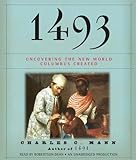by Charles C. Mann, Robertson Dean
Release Date: August 9, 2011
Buy new:
(Visit the Hot New Releases in Books on CD list for authoritative information on this product's current rank.)
Review & Description
From the author of 1491—the best-selling study of the pre-Columbian Americas—a deeply engaging new history of the most momentous biological event since the death of the dinosaurs.
More than 200 million years ago, geological forces split apart the continents. Isolated from each other, the two halves of the world developed radically different suites of plants and animals. When Christopher Columbus set foot in the Americas, he ended that separation at a stroke. Driven by the economic goal of establishing trade with China, he accidentally set off an ecological convulsion as European vessels carried thousands of species to new homes across the oceans.
The Columbian Exchange, as researchers call it, is the reason there are tomatoes in Italy, oranges in Florida, chocolates in Switzerland, and chili peppers in Thailand. More important, creatures the colonists knew nothing about hitched along for the ride. Earthworms, mosquitoes, and cockroaches; honeybees, dandelions, and African grasses; bacteria, fungi, and viruses; rats of every description—all of them rushed like eager tourists into lands that had never seen their like before, changing lives and landscapes across the planet.
Eight decades after Columbus, a Spaniard named Legazpi succeeded where Columbus had failed. He sailed west to establish continual trade with China, then the richest, most powerful country in the world. In Manila, a city Legazpi founded, silver from the Americas, mined by African and Indian slaves, was sold to Asians in return for silk for Europeans. It was the first time that goods and people from every corner of the globe were connected in a single worldwide exchange. Much as Columbus created a new world biologically, Legazpi and the Spanish empire he served created a new world economically.
As Charles C. Mann shows, the Columbian Exchange underlies much of subsequent human history. Presenting the latest research by ecologists, anthropologists, archaeologists, and historians, Mann shows how the creation of this worldwide network of ecological and economic exchange fostered the rise of Europe, devastated imperial China, convulsed Africa, and for two centuries made Mexico City—where Asia, Europe, and the new frontier of the Americas dynamically interacted—the center of the world. In such encounters, he uncovers the germ of today’s fiercest political disputes, from immigration to trade policy to culture wars.
In 1493, Charles Mann gives us an eye-opening scientific interpretation of our past, unequaled in its authority and fascination.
From the Hardcover edition.Guest Reviewer: Nathaniel Philbrick on 1493 by Charles C. Mann
 |
I’m a big fan of Charles Mann’s previous book 1491, in which he provides a sweeping and provocative examination of North and South America prior to the arrival of Christopher Columbus. It’s exhaustively researched but so wonderfully written that it’s anything but exhausting to read.
With his follow-up, 1493, Mann has taken it to a new, truly global level. Building on the groundbreaking work of Alfred Crosby (author of The Columbian Exchange and, I’m proud to say, a fellow Nantucketer), Mann has written nothing less than the story of our world: how a planet of what were once several autonomous continents is quickly becoming a single, “globalized” entity.
Mann not only talked to countless scientists and researchers; he visited the places he writes about, and as a consequence, the book has a marvelously wide-ranging yet personal feel as we follow Mann from one far-flung corner of the world to the next. And always, the prose is masterful. In telling the improbable story of how Spanish and Chinese cultures collided in the Philippines in the sixteenth century, he takes us to the island of Mindoro whose “southern coast consists of a number of small bays, one next to another like tooth marks in an apple.”
We learn how the spread of malaria, the potato, tobacco, guano, rubber plants, and sugar cane have disrupted and convulsed the planet and will continue to do so until we are finally living on one integrated or at least close-to-integrated Earth. Whether or not the human instigators of all this remarkable change will survive the process they helped to initiate more than five hundred years ago remains, Mann suggests in this monumental and revelatory book, an open question.
Read more
No comments:
Post a Comment